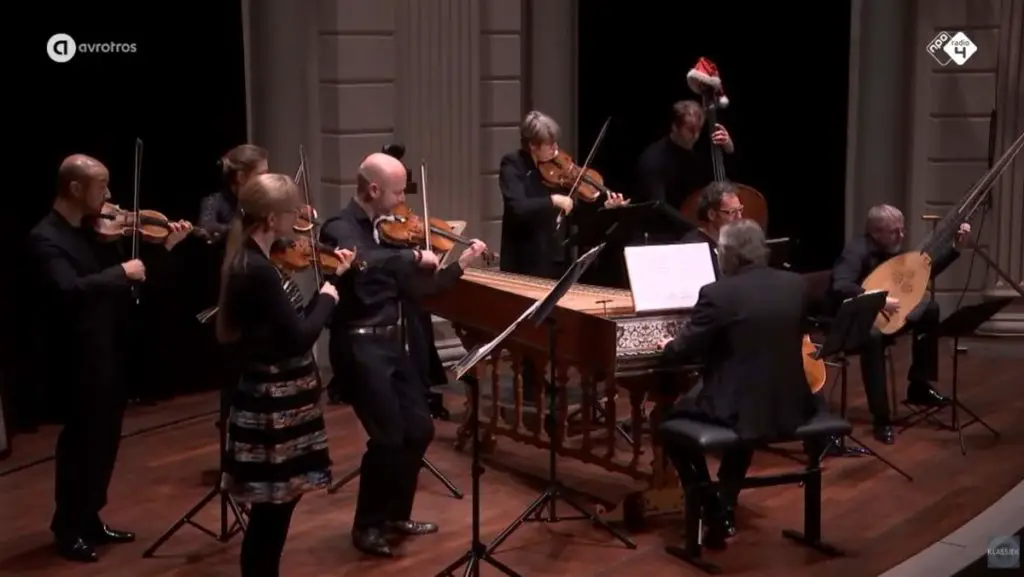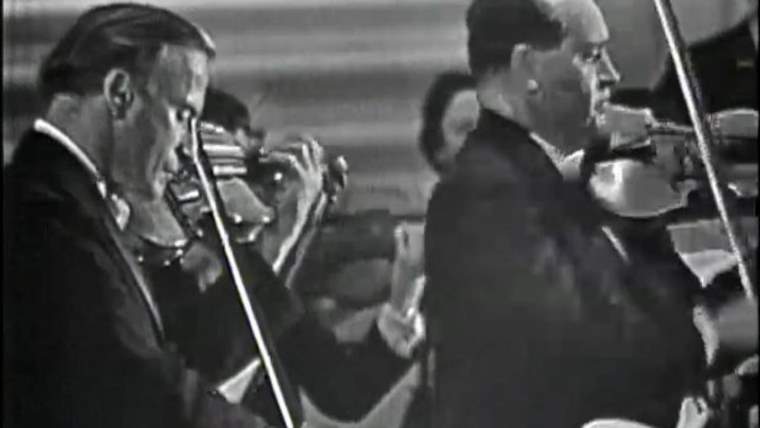Conducted by Tomasz Chmiel, the Kraków Young Philharmonic Orchestra plays Johann Sebastian Bach’s Concerto for Two Violins, Strings and Continuo in D Minor, BWV 1043, also known as the Double Violin Concerto or “Bach Double”. Violins (soloists): Natalia Stęposz and Zuzanna Bolon. This is the winning concert of the Polish Nationwide Music Schools’ Symphonic Orchestras Competition, 2014. At Witold Lutosławski Concert Studio of Polish National Radio.
Johann Sebastian Bach’s Concerto for Two Violins [Bach Double]
Johann Sebastian Bach’s Concerto for Two Violins, commonly referred to as the “Bach Double,” is one of the most famous works in the violin repertoire. This piece showcases the depth and breadth of Bach’s contrapuntal genius, as well as his exceptional ability to weave intricate musical dialogues.
Originating during his tenure in Köthen, where Bach served as Kapellmeister, the concerto was likely written between 1717 and 1723. This period in Bach’s life was characterized by his focus on instrumental music, leading to the creation of some of his most celebrated works.
The Concerto for Two Violins is characterized by its dialogues between the two solo instruments. The interplay between the two violins is exquisite, with each one taking its turn in the spotlight and also accompanying the other. The piece allows for an intricate and intimate conversation between the two instruments, with Bach’s characteristic fugal and imitative writing playing a significant role. This creates layers of conversation, not just between the two violins, but also between them and the orchestral accompaniment.
The texture of the concerto is rich and dense, with the orchestral parts providing a lush backdrop against which the solos shine. Bach’s harmonic language is both intricate and emotional, conveying a range of feelings from introspective melancholy to exuberant joy.
One of the remarkable features of this work is Bach’s ability to maintain a sense of balance. Despite the complexity of having two solo instruments and an orchestra, no part feels superfluous. Every note has a purpose, contributing to the overall structure and emotional narrative of the piece.
Performances of the “Bach Double” often captivate audiences with the beauty of the intertwined violin melodies and the complexity of Bach’s compositional techniques. Its enduring popularity is a testament to its timeless beauty and the depth of emotion it conveys.
Movements
Three movements with starting times:
- 00:23 Vivace
- 04:30 Largo ma non tanto
- 11:32 Allegro
1. Vivace
The first movement of Johann Sebastian Bach’s Concerto for Two Violins (BWV 1043) in D minor is marked “Vivace,” which translates to “lively” or “quick.” This movement embodies the Baroque concerto’s energetic spirit and showcases the essential features that make this piece a favorite among music enthusiasts.
From the outset, the movement is characterized by its driving rhythmic energy and the interplay between the solo violins and the orchestral ensemble. This dialogue is central to the concerto form, especially as articulated by Bach.
The two solo violins often engage in a musical conversation. At times, they echo each other, play in unison, or weave their melodies around each other in a tightly-knit contrapuntal fabric. This contrapuntal interaction, a hallmark of Bach’s style, ensures that the listener’s attention is constantly shifting between the two violins as they take turns presenting thematic material and accompanying each other.
Harmonically, Bach employs sequences and modulations that heighten the movement’s drama and tension. While the piece is in D minor, there are moments of light and shade as Bach explores related key areas, creating a rich tapestry of emotions.
The thematic material introduced at the beginning of the movement is recurrent, giving a sense of unity and cohesiveness to the entire movement. Yet, Bach’s genius ensures that each recurrence offers a new perspective or twist, ensuring the listener’s engagement throughout.
The first movement of the Concerto for Two Violins is a brilliant display of Bach’s prowess in thematic development, contrapuntal technique, and orchestrational balance. The lively “Vivace” marking is well justified as the movement bursts with energy, intricate musical dialogues, and a depth of emotion that only Bach could achieve.
2. Largo ma non tanto
The second movement of Johann Sebastian Bach’s Concerto for Two Violins in D minor is marked “Largo ma non tanto,” which can be translated as “slowly, but not too much.” This movement stands in stark contrast to the vivacious energy of the first movement and provides a deep, contemplative center to the concerto.
The mood of this movement is introspective and tender. Its beauty lies in its simplicity and emotional depth. The melodic lines of the two violins are sinuous and expressive, intertwining with each other in a soulful dialogue. Rather than the energetic back-and-forth seen in the first movement, here the violins often move together in harmonious parallel or engage in a gentle call and response.
The orchestral accompaniment provides a stable and warm backdrop to the violin solos. The harmonies are rich, with lush chordal progressions that support and enhance the violin melodies. Bach’s harmonic choices evoke a sense of yearning, melancholy, and, at times, transcendence.
One of the most striking features of this movement is the seamless blend of the two solo violins. The way Bach has crafted their parts, they seem to merge into one singular, unified voice, particularly during the moments when they play in close harmony or in canon.
This “Largo ma non tanto” movement has often been described as a musical meditation or a lyrical conversation between two intimate friends. Its serene and poignant atmosphere offers a respite from the outer movements’ more dynamic energy, and it stands as one of Bach’s most moving slow movements in his concerto repertoire.
In essence, the second movement of the Concerto for Two Violins showcases Bach’s unmatched ability to convey profound emotion through music. Its timeless beauty has made it a favorite for both musicians and listeners alike.
3. Allegro
The finale of Bach’s Concerto for Two Violins is marked “Allegro,” signifying a return to a faster tempo and a lively character, akin to the energy found in the first movement.
This movement is bustling with rhythmic vitality, beginning with a spirited theme introduced by the orchestra. Shortly thereafter, the two solo violins enter and quickly take up the musical material, diving into a dazzling display of virtuosity and intricate counterpoint.
The dialogue between the two violins is once again at the forefront of this movement. Bach masterfully weaves their voices together, sometimes in competition and sometimes in cooperation. The violins exchange motifs, chase each other in imitative passages, and occasionally unite for moments of harmonious agreement.
Rhythmically, the movement is marked by its dance-like character. The recurring rhythmic patterns provide a propulsive energy that drives the music forward. Amidst this buoyancy, there are moments of brief tension and release, which add to the overall drama and excitement of the movement.
Harmonically, Bach journeys through a series of modulations, creating moments of tension and resolution. These harmonic shifts, combined with the intricate contrapuntal interplay, give the movement its rich texture and dynamism.
This finale encapsulates the essence of the Baroque concerto’s spirit: it’s lively, full of contrast, and showcases both the soloists’ virtuosity and the composer’s genius in crafting complex yet accessible musical dialogues. The “Allegro” concludes the concerto on a high note, providing a satisfying and energetic end to this masterful work.
Kraków Philharmonic Orchestra
The Kraków Philharmonic Orchestra or the Symphony Orchestra of the Karol Szymanowski Philharmonic is a professional symphony orchestra based in Kraków, Poland. The national status of the orchestra is reflected in its program of events, including weekly symphonic concerts in the Wawel Royal Castle, or at the Jagiellonian University famous Collegium Novum, and prominent Kraków churches. The company is more active professionally than any other philharmonic orchestra in the country.

The Symphony Orchestra, presently residing in the Kraków Philharmonic, came into being in 1945. It was the first professional symphony orchestra in postwar Poland, formed at the local concert hall during the Soviet offensive.
The first postwar director as well as the conductor of the historic first performance held on February 3, 1945 (three months before the end of World War II in Europe), was Professor Zygmunt Latoszewski, a survivor of the Warsaw Uprising.
Sources
- Concerto for Two Violins (Bach) on Wikipedia
- Kraków Philharmonic Orchestra on Wikipedia


![Kokas, Kelemen: Bach - Concerto for Two Violins [Bach Double]](https://cdn-0.andantemoderato.com/wp-content/uploads/2024/01/Barnabas-Kelemen-Katalin-Kokas-Bach-Concerto-For-Two-Violins-Bach-Double-1024x576.jpg)